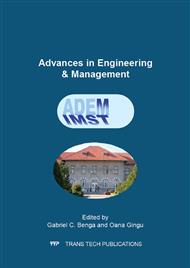p.19
p.23
p.29
p.37
p.42
p.48
p.54
p.59
p.67
Fracture Analysis of Porous P/M Iron Based Materials
Abstract:
Using powder metallurgy techniques new porous materials for self-lubricating bearings were developed. These materials are characterized by total porosity, which represents their major advantage for tribological applications, acting like their own oil reservoir. Sometimes the presence of pores can be also detrimental to the part performance. Among the causes of the bearings failure is their increased porosity for improving the lubricant retention capacity. Consequently, this can lead to a significant loss in strength. In the present work tensile test specimens based on Fe-Cu/brass-Sn-Pb powders were prepared in order to investigate the morphology of the fracture surfaces and to analyze the effect of pores on the failure process of these materials subjected to tensile loads. Distinct morphologies of the pores area were revealed by SEM images of the fracture surfaces.
Info:
Periodical:
Pages:
42-47
Citation:
Online since:
June 2015
Authors:
Permissions:
Share:
Citation:


